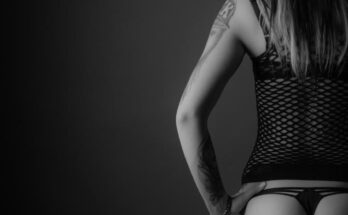Editor’s Note: We’ve removed our paywall from this article so you can access vital coronavirus content. Find all our coverage here. To support our science journalism, become a subscriber.
As the COVID-19 pandemic enters its seventh consecutive month, experts agree that masking is as important as ever to contain the spread of the virus. World Health Organization officials confirmed in July that SARS-CoV-2, the virus that causes COVID-19, can be spread through respiratory droplets (via a cough or sneeze) or from airborne transmission, when viral particulates spread long distances through the air. In both instances, face masks prevent the virus from entering into the nose and lungs, and can prevent transmission altogether or prevent severe infections if a person does get sick.
But despite being potentially life-saving, masks have been hard for some to accept. One national survey of nearly 60,000 respondents cites “discomfort” as the leading reason why some choose not to wear a mask in public. Many users report breathlessness, sweating, nausea and increased heart rate from masking — even though doctors have said repeatedly that masks do not inhibit the flow of oxygen.
So where are these side effects coming from, and what can people do to relieve their discomfort?
Discomfort Impacts How We Breathe
First things first: Wearing a standard surgical face mask or a cloth mask does not lower a person’s oxygen levels. Nor does mask wearing trap a significant amount of carbon dioxide, says Christopher Ewing, a lung specialist based in Alberta, Canada. Ewing, who regularly sees pediatric patients with asthma and cystic fibrosis, says that before the pandemic, his patients would often wear surgical masks in public to avoid respiratory illnesses that could be life threatening given their condition. In all but the most extreme cases, they’ve been able to mask safely.
But wearing a mask can still affect your breathing, Ewing says — just not in the way you might think.
“Most of us aren’t used to wearing face masks, and the sensation of having a mask on your face might make someone anxious or uncomfortable,” says Ewing. “Although much of our breathing is unconscious and driven by our respiratory center, it can also be influenced by the mind. When we’re feeling discomfort, even subconsciously, it can change the way we breathe.” For instance, if we exhale and it causes our glasses to fog
up, we might compensate for that discomfort by not exhaling fully on our next
breath.
Inhale, Exhale
Changing our breathing patterns subconsciously can lead to an abnormal breathing pattern: Either we hyperventilate, meaning we’re breathing too quickly, or we hypoventilate, meaning we breathe too slowly or too shallow. Either one of these dysfunctional breathing patterns can lead to the dizziness or breathlessness that people often mistake for a lack of oxygen or a buildup of carbon dioxide inside their mask.
“When someone hyperventilates, they start to breathe too deeply and too frequently, likely because wearing a mask is making them anxious or nervous,” Ewing says. Hyperventilation leads to a low level of carbon dioxide in the bloodstream, since the body is expelling C02 faster than it’s able to produce it. In turn, this causes dizziness, lightheadedness and can sometimes cause fainting.
Hypoventilation, on the other hand, occurs when we’re breathing too slowly or not exhaling as much as we need. In this case, the body’s carbon dioxide level rises, decreasing the amount of oxygen in a person’s bloodstream. Hypoventilation can cause sleepiness and a feeling of “air hunger,” a sensation where you’re unable to get enough air into your lungs. That feeling of gasping for air can also cause anxiety.
How to Breathe Better
The good news, Ewing says, is that if we find ourselves in a dysfunctional breathing pattern we can easily override it and get rid of any symptoms.
“The best strategy to reset our natural breathing pattern is something that is
common in yoga and also something that the U.S. Navy Seals use,” says Ewing. The strategy, called “box breathing” or “corner breathing,” has the person visualize a box and trace the outline of the four sides in their mind’s eye as they inhale and exhale slowly. Following the outline of the box, users breathe in slowly for four seconds, pause, breathe out completely, and then pause again. (A good visual for box breathing is here.) “This method helps us regulate our breathing in a more conscious way, and it also reduces stress and anxiety by activating the parasympathetic nervous system,” says Ewing.
Belly-breathing is another quick way to reset. “Sometimes with these dysregulated breathing patterns we’re just using our chest and neck muscles to breathe, which is inefficient and uncomfortable,” Ewing says. Instead, he recommends taking a few minutes to focus on using the diaphragm, a dome-shaped muscle that lives between the abdomen and chest. Diaphragmatic breathing, or belly-breathing, encourages optimal oxygen and carbon dioxide exchange, while also normalizing heart rate and lowering blood pressure. To practice belly-breathing, relax your hand and place it on the diaphragm, just below your rib cage. When you breathe in, your diaphragm should push your hand away from your body. On the exhale, your hand should return to you.
While breathing comes naturally to most of us, breathing with a mask is a skill that takes practice, Ewing says. When his pediatric patients with cystic fibrosis need to be taught to wear a mask for long periods, he recommends doing it for short periods during the course of the day and then building up tolerance. If mask-wearing is particularly uncomfortable, children — and adults — can normalize it by wearing a mask during a distracting activity, such as watching TV or playing video games. Soon enough, Ewing says, breathing with a mask will become second nature.
“It’s very similar to when you learn how to wear eyeglasses or use contacts,” he says. “The more you practice, the more you get used to it. Same goes with masks.”


